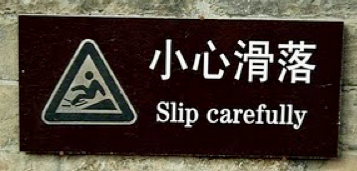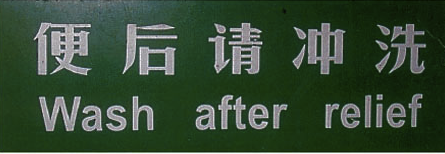Ch 3: Opener and Analysis
Unit Opener: Comments and Analysis
1. What do the signs indicate about differences between English and Chinese?
Chinese uses a different character set from English, which uses the Latin alphabet. Chinese has many different spoken varieties, which in some cases are very distinct from one another (Mandarin and Cantonese, for example). But they all use the same character set (also used in one of the character sets in Japanese, Kanji). Chinese characters are not phonetic, but rather are ideograms, representing a word or morpheme (the smallest meaningful unit of language). Chinese characters number in the tens of thousands and pose one of the challenges in learning the language. Chinese is much more succinct and dense than English (no definite or indefinite articles, for example). An article in The Economist ranked it by far the most efficient language for use in twitter.
2. Many Chinglish signs are professionally printed or type-set – how could such flagrant language mistakes escape proof-reading or even spell-checking?
The meaning of a Chinese character depends on what it’s next to, which makes dictionary look-ups not always very effective. Because taken out of context a string of Chinese characters could have a variety of meanings, assigning a precise English equivalent can be tricky. In some ways, the indirectness in the Chinese communication style is mirrored in the lack of specificity in the language. The language itself is high-context – characters in isolation have little meaning. The ambiguity can only be resolved by providing context. It’s probably also the case that Chinese printers lack the English proofing tools (after all, a whole different character set) needed.
3. Do the Chinglish signs reveal anything culturally about China?
Interest in learning English and wide-spread availability of English teachers is a fairly recent phenomenon in China, although it is growing now at a fast rate. China is like the USA in that it exhibits what I would call “big country syndrome”. If you’re from a small country (say Luxemburg or Denmark), the need to learn another language is a practical necessity. If you’re from a country with over a billion native speakers (by far the most in the world), things may look different. Americans tend to be monolingual for a variety of reasons, but one is certainly geographic and demographic.
4. What is likely to be the reaction of young Chinese who have learned English when they see Chinglish?
Depending on the particular instance of Chinglish, the reaction could be embarrassment (particularly if in the company of foreigners) or amusement. Some Chinglish signs in fact seem to have been created to entertain and attract attention. The Chinese government doesn’t see it that way. Before the Beijing Olympics, there was a concerted effort to eliminate Chinglish in areas likely to be visited by tourists.
5. Are there any counterparts in American culture to the Chinglish phenomenon?
How about the numerous tattoos of Chinese characters on NBA players or other athletes? One of the first in the NBA was Marcus Camby’s arm tattoo of 勉族, which means nothing in Chinese (something like striving minority people). There are many others that follow that pattern.
What’s the point of this unit’s opener?
There are many common elements among languages, as Chomsky and fellow linguistics have demonstrated. However, there are plenty of major differences, ones that become quite evident when you start to learn a language as different from English as is Chinese. Many Americans assume translation from one language to another is a simple process of word substitution. That doesn’t work for any set of languages but it’s even more the case with Chinese and English. Structurally and culturally, the languages are so different that translation between the two can be much more of an art than a science.

